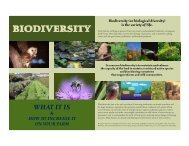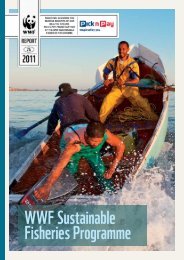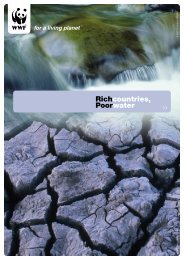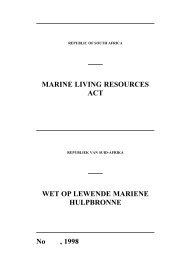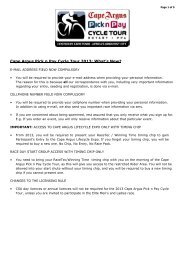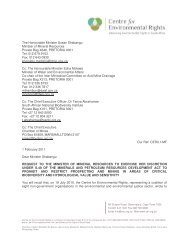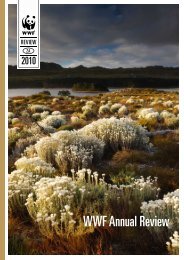State of Management of South Africaââ¬â¢s ... - WWF South Africa
State of Management of South Africaââ¬â¢s ... - WWF South Africa
State of Management of South Africaââ¬â¢s ... - WWF South Africa
- No tags were found...
You also want an ePaper? Increase the reach of your titles
YUMPU automatically turns print PDFs into web optimized ePapers that Google loves.
STATE OF MANAGEMENT OF SOUTH AFRICA’S MARINE PROTECTED AREASThe MPA is significant for fish conservation in <strong>South</strong> <strong>Africa</strong> as it is an important nursery areafor many reef fish species; it is central in the distribution range <strong>of</strong> several endemic species;protects large populations <strong>of</strong> commercially exploited species; and it supports a rich diversity<strong>of</strong> fish (202 species from 84 families), some species <strong>of</strong> which are Red Data species.Furthermore, there is evidence that several species have a high degree <strong>of</strong> residency, whichcombined with slow growth rates, makes them vulnerable to over-exploitation. In addition tothis, the MPA protects approximately 11% <strong>of</strong> the Warm Temperate <strong>South</strong> Coast rockyshoreline. The <strong>of</strong>fshore marine living resources in the MPA are in near pristine conditionwhile the inshore resources are exposed to illegal extraction.The MPA is an important eco-tourism attraction drawing approximately 170 000 local andinternational visitors annually. Recreational activities in the MPA include boat rides,snorkelling and diving, and the renowned Otter Trail and Dolphin Trail which run adjacent tothe MPA. Cultural and heritage resources in and related to the MPA include a wreck, an oldharbour and strandloper shell middens in caves along the shore. Furthermore, there hasbeen a significant amount <strong>of</strong> research and several educational programmes in the MPA.There is a long history <strong>of</strong> resource use in the area. In 2001 the whole MPA was declared ano take area under the MLRA. A number <strong>of</strong> communities, dependant on access to marineliving resources for their livelihoods, actively campaigned to retain access to the area butwere denied in 2007. This has come to be a major source <strong>of</strong> conflict and tension in the areaand has resulted in some locals resorting to illegal fishing in the MPA. SANParks staff allegethat there are approximately 30 persistent illegal fishers in the area.The threats to the MPA include: Illegal fishing; Continued political pressure to allow local communities access to the Park for fishing; The development <strong>of</strong> a golf course, estate and hotel in close proximity to the MPA; Minor abalone poaching on the borders <strong>of</strong> the MPA, and Fertilizer run <strong>of</strong>f from dairy farms in close proximity to the MPA.5.4.2 Legal frameworkPart <strong>of</strong> the marine section <strong>of</strong> the Tsitsikamma National Park was proclaimed as TsitsikammaMPA under the MLRA in 2000. Both the MLRA and the NEM:PAA are applicable to theTsitsikamma MPA. SANParks staff indicated that there was great value in the dualdesignation as the NEM:PAA provided greater scope to manage activities unrelated tomarine living resources.SANParks managers at Tsitsikamma MPA suggested that: the admission <strong>of</strong> guilt fines beincreased so to deter illegal fishing; the MPA be extended so to include the boundaries <strong>of</strong> theDe Vasselot marine section and to create a 0.5 nautical mile buffer zone around the MPA;diving be banned throughout the National Park and that a transit through the MPA be bannedfor enforcement purposes.Pg 61



